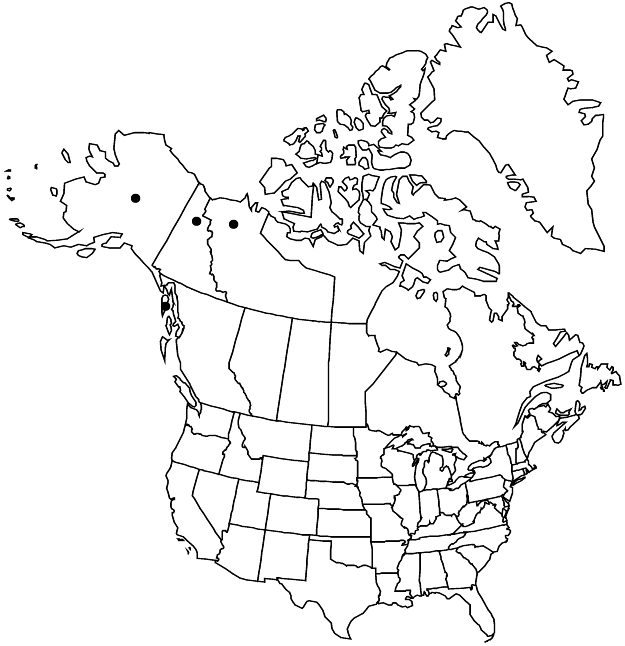Difference between revisions of "Minuartia arctica"
in P. F. A. Ascherson et al., Syn. Mitteleur. Fl. 5(1): 772. 1918.
FNA>Volume Importer |
FNA>Volume Importer |
||
| Line 15: | Line 15: | ||
|name=Alsine arctica | |name=Alsine arctica | ||
|authority=(Steven ex Seringe) Fenzl | |authority=(Steven ex Seringe) Fenzl | ||
| − | }}{{Treatment/ID/Synonym | + | }} {{Treatment/ID/Synonym |
|name=Lidia arctica | |name=Lidia arctica | ||
|authority=(Steven ex Seringe) Á. Löve & D. Löve | |authority=(Steven ex Seringe) Á. Löve & D. Löve | ||
| Line 33: | Line 33: | ||
|elevation=0-1000 m | |elevation=0-1000 m | ||
|distribution=N.W.T.;Yukon;Alaska;Asia. | |distribution=N.W.T.;Yukon;Alaska;Asia. | ||
| − | |discussion=<p>Minuartia arctica is an amphi-Beringian species that is known to intergrade with M. obtusiloba. Hybrids between M. arctica and M. macrocarpa are known as well.</p> | + | |discussion=<p><i>Minuartia arctica</i> is an amphi-Beringian species that is known to intergrade with <i>M. obtusiloba</i>. Hybrids between <i>M. arctica</i> and <i>M. macrocarpa</i> are known as well.</p> |
|tables= | |tables= | ||
|references= | |references= | ||
| Line 57: | Line 57: | ||
|publication year=1918 | |publication year=1918 | ||
|special status= | |special status= | ||
| − | |source xml=https://jpend@bitbucket.org/aafc-mbb/fna-data-curation.git/src/ | + | |source xml=https://jpend@bitbucket.org/aafc-mbb/fna-data-curation.git/src/8f726806613d60c220dc4493de13607dd3150896/coarse_grained_fna_xml/V5/V5_243.xml |
|subfamily=Caryophyllaceae subfam. Alsinoideae | |subfamily=Caryophyllaceae subfam. Alsinoideae | ||
|genus=Minuartia | |genus=Minuartia | ||
Revision as of 17:37, 18 September 2019
Plants perennial, mat-forming. Taproots stout, woody. Stems erect to ascending, green, 3–10 cm, retrorsely puberulent or stipitate-glandular, internodes of flowering stems 2–6 times as long as leaves. Leaves tightly overlapping (vegetative) or variably spaced (cauline), usually connate proximally, with tight, scarious to herbaceous sheath 1.2–1.5 mm; blade straight to outwardly curved, green, obscurely 1-veined, linear (proximal vegetative) or subulate (cauline), rounded 3-angled (abaxial surface thickened, rounded, adaxial surface flat to concave), 5–20 × 0.4–1 mm, flexuous, margins not thickened, herbaceous, often ciliate, apex often purple, rounded to truncate, shiny, glabrous (vegetative) or glabrous to stipitate-glandular (cauline); axillary leaves absent. Inflorescences: flowers solitary, terminal; bracts narrowly lanceolate to oblong, herbaceous. Pedicels 0.5–3 cm, usually densely stipitate-glandular. Flowers: hypanthium cup-shaped; sepals prominently 3-veined proximally, lanceolate to narrowly ovate (herbaceous portion often purple, ovate to oblong), 4–8 mm, enlarging slightly in fruit, apex often purple, rounded, hooded, stipitate-glandular; petals oblanceolate, 1.5–2 times as long as sepals, apex broadly rounded, entire. Capsules narrowly ellipsoid, 9–10 mm, longer than sepals. Seeds brown, suborbiculate with radicle prolonged into beak, compressed, 1.2–1.6 mm, minutely tuberculate (50×). 2n = 22 (Russia), 26 (Russia), 38 (Russia), 52, ca. 80.
Phenology: Flowering summer.
Habitat: Dry ridges, rocky mountain slopes, heathlands, alpine snowbed slopes, stony tundra
Elevation: 0-1000 m
Distribution

N.W.T., Yukon, Alaska, Asia.
Discussion
Minuartia arctica is an amphi-Beringian species that is known to intergrade with M. obtusiloba. Hybrids between M. arctica and M. macrocarpa are known as well.
Selected References
None.